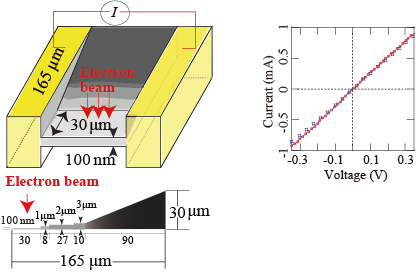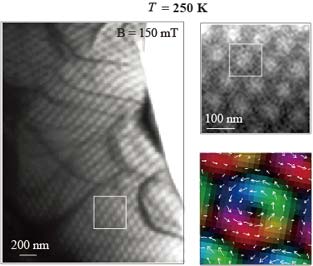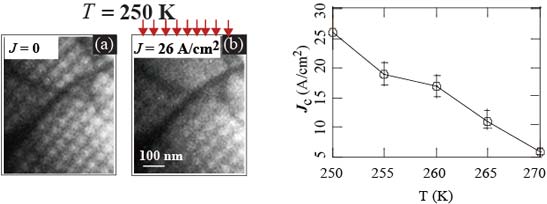Oct. 1, 2013
Low-power-consumption magnetic memory element
RIKEN No.: 08092
Inventors
Xiuzhen Yu, Yoshinori Tokura, Naoya Kanazawa and Yoshinori Onose
Background
Magnetic memory elements using electron spin orientation as digital information have characteristics such as high speed and nonvolatility, and they are used in various fields. Flowing electricity inside a ferromagnetic body causes the magnetic domain wall to move and magnetization reversal, which makes it possible to write information. However, a high electrical current density of at least 109 A/m2 is required to move a magnetic domain wall. Because this causes much energy loss (power consumption is large), a method of operating a magnetic information carrier at a lower current density was desired.
Summary
An FeGe microdevice was produced to verify the current drive of skyrmions, and it was successful in driving skyrmions near room temperature (to−3°C) at the minute current of approximately 1/100,000th or less of the current density required for driving the magnetic domain wall in a ferromagnetic body. A microdevice with a height of 165 μm, and width of 100 μm, and a depth of 100 nm to 30 μm, depending on the position of the height direction was produced, and when an approximately 150 mT magnetic field was applied at a temperature of −23°C to near room temperature (−3°C), skyrmion crystals in which stable skyrmions having a diameter of approximately 70 nm were arranged in a triangular lattice were observed.

Fig.1 Schematic of FeGe microdevice (left) and its I-V curve (right)

Fig.2 Skyrmion crystal observed in the FeGe microdevice
Lorentz TEM image (250K, 150mT)

Fig.3 Current-driven skyrmion motion (left) and temperature profile of the critical current density (right)
Merits
- Can drive skyrmions at a minute electric current(>5X 104A/m2)
- Can produce skyrmion crystals that are stable near room temperature
Applications
- Next-generation, low-power-consumption magnetic memory elements
- Various skyrmion devices
References
- 1.Japanese patent No.6116043
- 2.X. Z. Yu, et al., Nature Mater. 10, 106-109 (2011)
- 3.X. Z. Yu, et al., Nature Commun. 3: 988 (2012)
